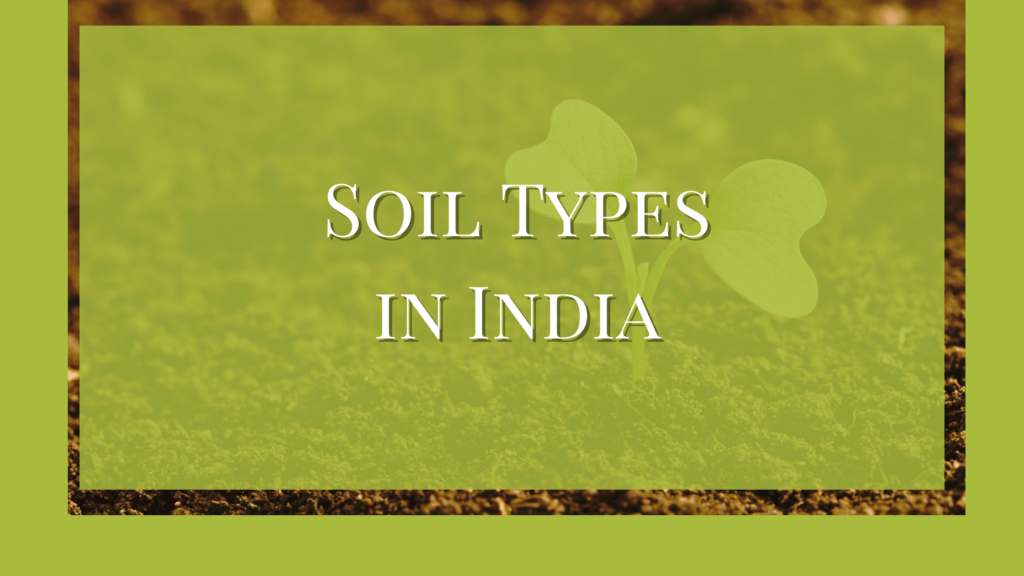Govinda Rajan and Gopala Rajan have reported 27 different types of soil in India. They have been divided into different categories as given below.
Alluvial Soil
Alluvial soil originates from the materials transported from the outside and has no chemical relationship with the underlying rock. They have been found throughout the sides of rivers and seas. They constitute a very important group because of their agricultural fertility and productivity. Of all the different types of soil in India, almost 43% is of this type. Alluvial soil can be categorized into.
- Old alluvial soil has a more clayey texture with a darker color.
- Recent alluvial soil with a lighter texture allows rapid and extensive development of roots.
Alluvial soil in India is seen in Punjab, Rajasthan, Haryana, Uttar Pradesh, Bihar, West Bengal, Maharashtra, Tamil Nadu, Andhra Pradesh, Assam, etc.
Saline and Alkaline Soil
Larger areas of Indian soil are seriously affected by the presence of salts and alkalis and they are unable to support any vegetation. Such soil is generally unproductive and is widespread in UP, Punjab, Madhya Pradesh, Tamil Nadu, etc.
In regions of low rainfall, the soluble salts tend to accumulate in the superficial layers of soil where the drainage facility is faulty. These salts include carbonates, chlorides, sulfates of sodium, and some calcium and magnesium as well.
Saline and alkaline soils bear practically no vegetation because plants cannot absorb water from such soil. But some species such as Suaeda fruticosa and Salicorma, etc can survive such conditions.
Desert Soil
This type of soil is found in Rajasthan and southern Punjab. The soil is sandy, derived partly from rocks and partly blown down from coastal areas of the Indus Valley. Here, water availability is poor and the vegetation is sparse. Plants like Acacia, Opuntia, Euphorbia, etc are some common inhabitants of such soil.
Black Soil
Also known as Black Cotton soil, its color varies from dark brown to deep black. It is derived partly from organic matter and partly from double-hydrated silicates of iron and aluminum. They are sticky when wet but contract and develop cracks upon drying.
It contains 40-60% clay fractions and the rest is grey-brown or pale brown loam as well as silt. Such soil covers about 15% of the country and is found in Madhya Pradesh, Andhra Pradesh, Karnataka, Punjab, Maharashtra, etc.
Cotton is the most important commercial crop grown in black soil. The common plants grown in this soil include Theonia and Gardenia.
Red Soil
Red soil is derived from weathering igneous and metamorphic rocks. Almost 18.5% of soil in India is of this type. It is usually more porous than black soil. Red soil contains a larger amount of iron which disintegrates under high temperatures and diffuses as iron oxide in soil to yield the characteristic red color.
In India, red soil is seen in Rajasthan, Andhra Pradesh, Madhya Pradesh, Maharashtra, Uttar Pradesh, Bihar, etc. The plants that grow in this soil include Terminalia, Acacia sps, Cassia sps, etc.
Laterite Soil
Laterite soil is peculiar to India and some other tropical countries with intermittent and moist climates. The organic content of this soil is high but deficient in magnesium, potassium, and phosphorus.
It is derived from granite and basalt rock, strongly leached and weathered under prevalent tropical climatic conditions. The soil is acidic and suitable for paddy, arecanut, etc, in lower altitudes. In the higher altitudes, laterite soil supports the cultivation of coffee, tea, rubber, cardamom, etc.
This soil is seen in West Bengal, Kerala, Andhra Pradesh, Karnataka, Maharashtra and Orissa.
Skeletal Soil
This type of soil is mainly seen in highlands in the drier regions of the peninsula and the Himalayas. It supports markedly xerophytes or degraded communities of vegetation. Here both rainfall and temperature are poor so weathering is slow. Thus the soil remains shallow with no profile development.
It is further exposed to erosion and has a pale to dark brown. Its texture is sandy to loam. The vegetation in this type of soil is sclerophyllous or hard type.
Peaty Soil
Peaty soil is seen in Kerala and north Bihar. It accumulates on the upper surface of the soil and supports a special type of woody vegetation. The soil is highly acidic and heavily black in color.
Marshy Soil
Marshy soil is also called Boggs, which is water-logged and deficient in nitrogen and oxygen. It is seen along the coastal track of West Bengal and Orissa as well as on the southeast coast of Tamil Nadu. The common plants that grow in such soil include Rhizophora, Avicennia, Dalbergia, etc.
Terai Soil
Terai soil is found in the foothills of the Himalayas from Punjab to West Bengal. It is mostly transported soil through erosion from high altitudes. The soil contains gravel, stones, clay, sand, and silt.
The soil is made of debris brought down by hill streams and erosion. The water drainage of this soil is adequate and moderately fertile. The dry terai soil is called Babar soil.
References
- Team, C. (2023, September 13). Soils of India: Classification and Characteristics – Clear IAS. ClearIAS. https://www.clearias.com/soils-of-india-classification-characteristics/
- Shukla, R.S. and Chandel, P.S. (2001) Plant Ecology. S. Chand and Company Ltd., New Delhi.
- Verma, P.S., Agarwal, V.K. (1999). Cell Biology Genetics Molecular Biology Evolution and Ecology. New Delhi: S.Chand Co.(Pvt) Ltd.




